First
Africa Page
1 April 1998
After arriving in Johannesburg from
Mauritius we spent three very hectic days getting organized for our month-long driving
tour of South Africa and Namibia. Our hotel is in the suburb of Sandton, which is a
district not at all typical of rest of Jo'berg in that it is new and prosperous and clean.
But even in this supposedly safe neighborhood exists a pervasive sense of tension, with
bars on all the windows and Uzi-packing security forces evident at every turn.
At noon on April Fool's Day we left
Jo'berg in our rented Audi station wagon and drove 700 km's west through scrubby arid
country to the town of Kuruman. Ten km's outside of town, and well after dark, an armed
guard passed us through the gate of the Red Sands Lodge. An eland crossed in front of us
as we drove down the 5km track to our bungalow.
2 April 1998
Next morning we went back into town and
stopped at the Eye of Kuruman, an artesian spring that gushes 2000 gallons/minute of cold,
sweet water out of a rocky outcropping. It is this spring that made possible the initial
settlement of an otherwise inhospitable land.
 |
A short way out of town is the preserved mission of
Robert and Mary Moffat, who overcame incredible obstacles to establish the first mission
and white settlement north of the Orange River. The inspiring story of Mary Moffat is
immortalized in the book "Beloved Partner" (Kaaren and Dan both loved it). An
almond tree still stands at the mission where a young David Livingstone proposed to the
Moffats' daughter. |
400 km's west we found a little
guesthouse in Uppington. The only other resident was a gentleman from Capetown named
Johann Van der Merwe. Like every other Kapstadter we met, Johann is a connoisseur of fine
wines. He befriended us and took us out to dinner at a small restaurant named Le Must
where we enjoyed the finest gourmet meal we've ever eaten, anytime, anywhere.
3 April 1998
First thing each day for a week now,
and each morning for the next two months, we'll begin the day taking a couple of
foul-tasting anti-malaria pills with breakfast.
| We headed north on a dirt road into the Kalahari
Desert. Along the way we came across a bushman family camped by the road, selling
necklaces they make from ostrich shell, springbok horn, and porcupine quills. |
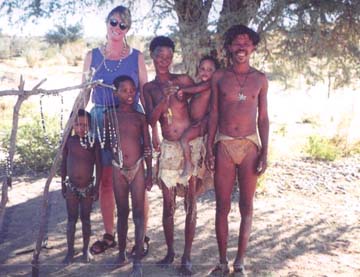 |
280 kilometers north of Upington we
entered Gemsbok-Kalahari National Park and at the reception center met ranger Belinda
Mattee. Our waitress at Le Must the night before (Francesca) is a friend of Belinda's and
she said we should look for her. Belinda gave us maps and told us park regulations,
including the proscription against getting out of our car for any reason whatsoever for
the next 180 kilometers, until we reached the fenced enclosure at Mata Mata.
Bought some ostrich and springbok
biltong, gassed up, and headed north, driving right up the bed of the Aoub River. This
normally dry land has been wet by intermittent heavy rains in the last couple weeks. For
one day last week water flowed in the Aoub River for the first time in twenty years. The
water has already disappeared, but the land is bright green with new growth, and is
carpeted with brilliant yellow and pink flowers.
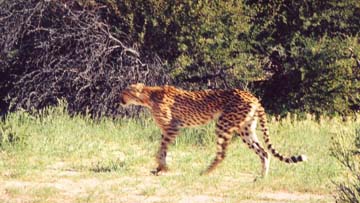 |
Right away we started seeing
animals: gemsbok, blue wildebeest, springbok, ground squirrels, meerkats, ostriches. Then,
right alongside the road, two cheetahs sauntered by, going nowhere very fast and seemingly
oblivious to our presence. It was just past midday with the sun beating down, and after a
bit the slinky cats plopped down under an acacia to wait out the heat of the day.
We continued on, stopping every few
minutes when Tyler spotted a new bird. So many new and fascinating birds: Bustards,
Secretary birds, Lilac-breasted Rollers, Whydas, Drongos, and many new raptors. |
Twenty k's before Mata Mata we spotted
a pride of six fat lionesses curled up under a tree on the hillside above the riverbed. A
herd of springbok grazed unconcerned on the new grass barely a hundred meters away,
somehow knowing that the predators were sated and lazy. Seeing wild lions for the first
time, we were especially impressed with the awesome size of these big cats. We watched
them for a half-hour, but they acted very contented and didn't do anything but
occasionally yawn, lick each other and roll over from one side to the other.
| We came across a bakkie in which sat a man
earnestly photographing something in the branches of a thorn tree overhead. We stopped to
ask what he saw and he told us to keep an eye on the sociable weaver nests right above us.
Moments later a Cape Cobra slowly slithered out of one hole, searched around a bit, and
crawled into another. All the weavers flitted about and scolded at the snake, but they
didn't act too upset because it's not the time of year for eggs or fledglings. He wasn't
likely to catch one of the adult birds, so it wasn't apparent why the hunter was going to
all the trouble. |
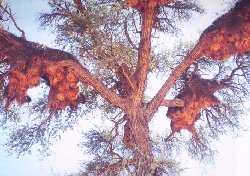 |
Shortly after five we pulled through
the gate at Mata Mata and moved into our bungalow. If not inside the camp before the gate
is locked at 1830, you're automatically assigned a very heavy fine. No one will be allowed
outside until 0700 tomorrow morning. We built a camelthorn fire in the braai out back and
barbecued lambchops.
4 April 1998
We were ready to leave the camp when
the gates were opened shortly before 0700. We drove south for a ways, then turned west to
cross the dune country between the valleys of the Aoub and Nossob Rivers. It is hot, dry
terrain with sparse vegetation, and besides birds and lizards all we saw were ostriches,
wildebeest, springbok and gemsbok. The gemsbok are our favorite. They are big,
silvery-grey antelope with beautiful black and white markings. Their long, spear-like
horns make them look like they'd be a formidable prey for anything other than a concerted
attack from several directions at once.
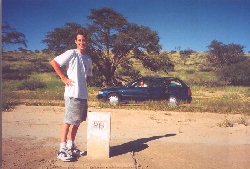 |
Every few kilometers back in the brush were small
concrete monuments marking the frontier between Botswana and the ZAR. Contrary to the
rules, we all jumped out of the car, first looking around for lions, and scampered across
the sand to run around one of these monuments . . . just to say we'd been to Botswana. |
We checked into the camp at Nossob, and
then drove back out and headed north to explore along the riverbed. Not much new until a
few kilometers from camp we drove to the top of a rise and on a far hillside Kaaren
noticed a beautiful, tawny-red caracal sneaking through the bushes. It is the largest of
the African small cats, weighing up to 20 kg.
Then Tyler spotted some jackals
worrying the bony remains of a gemsbok which lions had killed that morning. As we watched,
one-by-one, a pride of two females and two males walked out of the bush in front of us.
Their bellies were so engorged that they could barely walk. It dawned on us for the first
time what a tremendous effort these predators must put into not only making a kill, but in
forcing down as much meat as they can possibly hold. They looked very uncomfortable, and
covered only a few hundred meters before they again plopped down in the brush to rest.
05 April 1998
We woke an hour before dawn to the
awesome and spine-tingling sound of lions roaring outside the camp fence. We ran down to
the hide above the waterhole just in time to see the same pride of lions we'd seen leaving
their kill the evening before come filing up one by one for their first drink since
gorging on the gemsbok. Their bellies were still swollen and it had taken them all night
to travel the six k's from their kill to the waterhole at Nossob. After drinking they
plopped down on a little dune for lots of licking and grooming and then went to sleep.
From Nossob we started the 160 k drive
south down the dry bed of the Nossob River, back to Twee Rivieren. Many stops along the
way for viewing birds and animals. Kaaren spotted a Giant Eagle Owl in a tree alongside
the road; it looks much like a horned owl, but the size of a bald eagle. At one point a
beautiful two meter-long, golden-colored Cape Cobra crossed the road right in front of us.
T. and D. jumped out of the car to give chase, but it slithered down a squirrel hole.
Upon arrival back at Twee Rivieren we
checked in with Belinda, and as promised us several days before, she'd made arrangements
for us to visit the San village of Dawid Kuiper (he played the lead role in 'The Gods Must
Be Crazy').
| After her shift ended at 1900 she and a co-worker
named Erika climbed into our car we and headed out to the Bushman encampment. At the camp
we met Dawid and his extended family. There is little romantic to observe about the
present lifestyle of this pathetic bunch who not very long ago survived so elegantly in
the harsh desert environment. We sat around the cooking fire with Dawid’s family
while he described to us (with Belinda translating) the plight of his people . . . how
they’d been denied access to the wild Kalahari when it became a national park. |
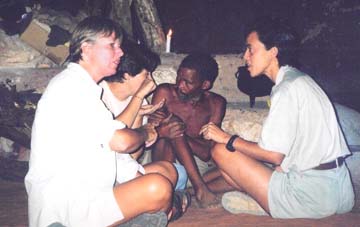 |
They wandered aimlessly, constantly
harassed and jailed by the white farmers every time they unknowingly crossed onto private
holdings. Finally a sympathetic landholder let them build some mud and tin shanties on his
land, where they’ve lived since, surviving on income from beads and trinkets they
sell to tourists alongside the road. Belinda has selflessly become their leading advocate
in an attempt to find some remote piece of desert where they might rejuvenate their
traditional lifestyle.
 |
But still they laugh. They are gentle and friendly,
welcoming and gently taking your hand in both of theirs when you first meet them. The
youngsters were fascinated with Tyler, shyly touching his skin and hair. Since we left
home he'd been hauling around a collection of glow-in-the-dark plastic bugs for such an
occasion, and the littlest ones were ecstatic as he handed them out one-by-one. Dawid's
wife, Khasa, seemed very pleased with the bag of bread, sausages and canned fruit we'd
brought along for her. |
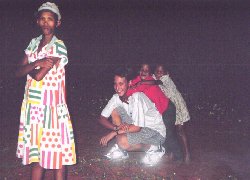 |
 |
Before we left, Dawid's eldest son, Ricci, dressed
in loincloth and ankle rattles, performed a rain dance around the fire. Like the other
young people we talked to, he places no value in formal education and says he wants only
to know the skills and traditions that Dawid tries to preserve for them. But with no land
available for them to wander, the juveniles are directionless and bored, and drug and
alcohol abuse is rampant. It was a joyous and enlightening experience to meet these dear
people, but we couldn't help feeling depressed at contemplating their apparently bleak
future. |
06 April 1998
Packed up and said goodbyes to Belinda
and Erika. Drove 360 k's west on gravel roads across desert, crossing the border into
Namibia at the small town of Rietfontein. After gassing up and lunch in Keetmanshoop we
turned north on the main highway and traveled another 260 k's to Hardap Dam, where we
found a small bungalow built above the lake.
Scampering and chittering among the
boulders between us and the lake were families of Rock Dassies, also known as hyrax. These
charming, marmot-sized critters are most peculiar in that, though they look kind of
ground-hoggy, they're not even remotely related to rodents. Their closest relatives are
hippopotami and dugongs!
Dan had an Oryx steak for dinner. Ty
had ostrich. Both were lean, tender, and tasty. South Africa and Namibia are good bargains
for those with dollars to spend, and excellent meat is especially cheap. Complete dinner
of a large beef filet costs only $4-5. |
 |
07 April 1998
Hardap Dam to Windhoek.
08 April 1998
A rooster in a tree outside our window
woke us up at 0400. D. went outside to ask him to pipe down. Even after pelting him with
rocks, he wouldn't shut up. So D. grabbed him by the neck and dragged him out of the tree,
waking the whole camp in the process.
On our way out of Windhoek we stopped
in town to purchase a camelbone necklace that K. had fallen in love with the day before.
Then we headed north toward Etosha Park, passing through the towns of Okahandja and Outjo.
Ahead of us we see puffy cumulus clouds rapidly growing vertically and darkening; looks
like serious rain. We checked in through the park gates at 1530 and headed on to the main
camp at Okaukuejo. Lots of game. At one point we had to stop for a baby Springbok standing
in the road that froze and didn't know where to turn when he saw the car . . . lion food
for sure. Upon arrival at Okaukuejo we moved into the rondavel we had reserved more than a
year previously.
09 April 1998
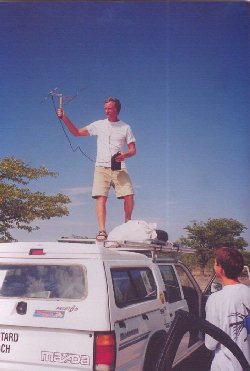 |
Spent the day cruising Etosha. We'd
not seen a soul all morning until we drove down into a sandy wallow and spotted Tim and
Laurel Osborne setting up antennae and electronic paraphernalia on top of their bakkie.
They are wildlife biologists formerly from Alaska, retired now and working in Etosha
studying Kori Bustards.
. . . a fun coincidence . . .
Scott, for twenty years Tim was the
game ranger for a large chunk of the Brooks Range that included the drainage of the
Koyokuk River (where once upon a time Dan and Scott had their Great Grizzly Bear Hunt). |
10 April 1998
| Today we explored the country between Okaukuejo and
the camp at Namutoni. Saw male lions at Goas. We still hadn't seen any elephants, though
their sign was everywhere . . . ripped-off tree limbs and impressive dung piles in the
road. |
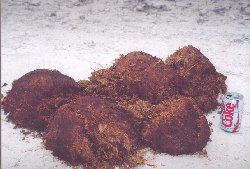 |
 |
While taking this poop picture, a big old bull
elephant came crashing out of the brush right in front of us. Naive tourists that we are,
we thought could just sit and watch and that he'd ignore the presence of our car, as had
all the other animals we had so far encountered. The theory is that, in this land of
perpetual eat-and-be-eaten, the animals respond only to what they can eat, or might eat
them. A t that juncture nobody had told us that solitary elephants and Cape Buffalo bulls
were to be treated differently. When he finally deigned to notice us, this old,
broken-tusked bull was only a car-length or so away. Suddenly he started trumpeting,
ripping trees apart and throwing them around. We got the message and made a hasty exit. |
| After the elephant, our best animals of the day
were little ones: Elephant shrew, Flamingos, Dwarf Mongoose. We stopped to let this
beautifully-marked, lazy snake cross the road in front of us and Dan hopped out to take a
picture. That evening we looked it up in our reptile book and identified it as a
Puffadder, one of Africa's deadliest snakes. |
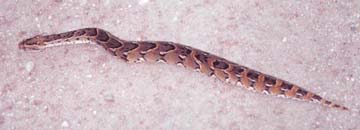 |
Next up is the:
Second
Africa Page . . .
dktdavis@aol.com













